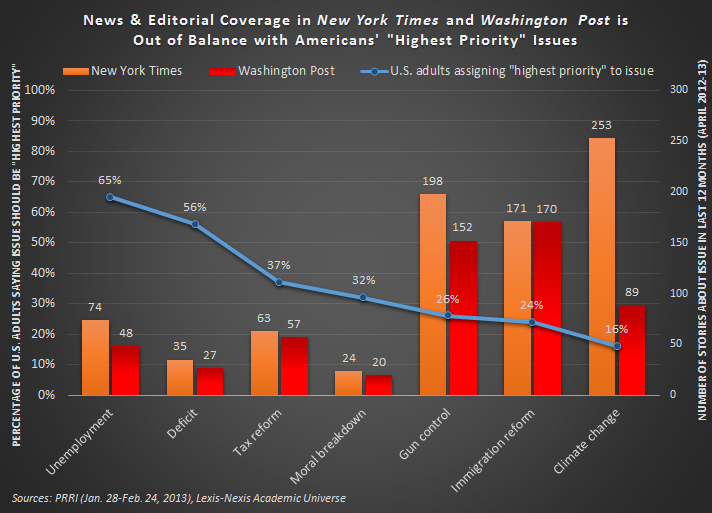What could I possibly have seen that leads me to make such a conclusion? Data from a study done by Public Religion Research Institute (PRRI), shared by the folks over at CARA (the Center for Applied Research in the Apostolate). That’s where the neat graph above comes from.
Here’s a taste of the good news that comes along with the neat graphs,
What effect could this be having? Newspapers have seen diminishing subscriptions, sales, and advertising for years. Many, including The New York Times and The Washington Post, are exploring the paywall business model to stay afloat. This model produced a minor positive effect in the last year but may generate sufficientrevenue in the long run. The conventional wisdom is that this sector’s troubles are entirely related to technological change. “It’s just a transition from print to digital.” But is there anything else going on? I think there is and as shown above its about content. Some editors and reporters seem not to realize that even a large majority of Americans may agree or disagree with a particular policy but that doesn’t mean that the policy isimportant or interesting to them. They seem to be failing to ask “What do my readers or viewers really want to know about?” People are unlikely to pay for content that is not highly relevant or interesting to them. For example, nearly nine in ten Americans (including me) support mandatory background checks for gun purchases. But that does not mean this same number of people want to read a news story about the issue every day. Especially when many of those potential readers are struggling with other issues that get such less frequent and prominent coverage.
Pope Francis recently called upon Catholics and others to devote more attention and effort to fighting poverty. In a previous post I noted that the Catholic Church in the United States was more likely than either political party to talk about this issue during the 2012 election campaign while the Democrats and Republicans almost exclusively addressed the “middle class.” In a similar fashion the The New York Times and The Washington Post are failing to sufficiently cover this issue. It is the case that 106 stories or columns were written about poverty in the last 12 months (April 2012 to April 2013) in both papers combined. At the same time, for every story about poverty about four were written about the issue of same-sex marriage (402 in total). I’m not saying the latter is unimportant by any means. There are many who feel strongly about the issue and are deeply engaged in this debate. But there are likely more Americans who will struggle to feed their families tonight (government estimates indicate there are some 46 million people in America living in poverty). The lack of coverage about poverty by the media is not just a simple artifact of the two papers examined above. Other more systematic studies of the news media concur (1, 2, 3).
American news seems to be increasingly crafted for the viewing pleasure of those sitting atop Maslow’s Hierarchy of Needs—the more well-to-do “post-materialists” who are most interested in the “wedge” or cultural issues and don’t want to be bothered by news about the poor or the economy in general (…the type of person who expresses confusion at how so many aren’t as concerned as they are about the environment without realizing that if you don’t know where your next meal is coming from the size of your carbon footprint just doesn’t often cross your mind). Reversing growing levels of poverty would require a focus on jobs and it is no surprise that this is considered “high priority” and among the “most important” problems facing the country by the American public. The United States has been experiencing one of the longest stretches of sustained high unemployment even as the size of the labor force (people who have or are seeking jobs) has fallen to 1979 levels (…there are 94 million more people in the U.S now than in 1979). Yet neither The New York Times nor The Washington Post could manage to write at least 75 stories and columns on unemployment in the last year?
“Advocacy news” on cable television may also be part of this sector’s problems. Pew studies have documented the highly partisan nature of Fox News and MSNBC programming and that the latter is much more focused on opinion than news (…viewers of both networks are less likely than others to be knowledgeable and informed). Now a forthcoming study by Princeton political scientist Markus Prior indicates that these outlets are essentially becoming the media hangouts for partisan activists at either end of the spectrum while many in the political middle are off watching The Food Network, ESPN, Dancing with the Stars, Here Comes Honey Boo Boo, etc. As Prior concludes, “The main danger of this more partisan media environment is not the polarization of ordinary Americans, but a growing disconnect between increasingly partisan activists and largely centrist and modestly involved masses. The median voter has never been so bored.”
Do you know what is anathema to the mission of disciples of the Church? The quagmire of political partisanship. The data presented in this study is one of the reasons why I a) generally don’t watch the news, and b) when I do, I tend not to get all freaked out by what is presented there. I’m interested in the Good News, see, and frankly that is rarely, if ever, covered in the mainstream media these days.












